Don't wanna be here? Send us removal request.
Text
Of Final Scenes

There’s a strange, mournful beauty in a film’s final scene—the way it lingers. These moments transcend simple endings; they awaken truths that were always hidden in plain sight.

I think of the way The Sixth Sense breathes its final revelation, peeling back the veil to expose a truth that reshapes every prior moment. It feels less like a twist and more like a ghostly hand reaching through the ether, gently altering everything you thought you understood. Or the raw intimacy of Call Me by Your Name, where Elio’s silent tears shimmer like fractured glass before a dying fire—love and loss forever entwined, their presence a quiet, eternal ache.

And Inception. That spinning top teeters between certainty and mystery, suspended in its hypnotic waltz. It refuses finality, instead inviting endless contemplation. Life, too, is unresolved in this way—achingly imperfect, impossibly beautiful. These endings speak to me as an artist because they embody the creative process itself: the simultaneous act of revealing and obscuring, constructing and erasing.
In my own work, I chase this feeling—the last note that hovers in the air, trembling like the delicate strands of a spider’s web. Like the closing of Black Swan, where perfection and obliteration blur into a singularity of haunting beauty, I want my music to leave its shadow upon those who listen, an indelible imprint of grief, ecstasy, and transformation.
Art, like life, is ephemeral yet infinite. Endings transform us, opening doors to the unknowable. They are less conclusions and more thresholds, places where we confront the vast, unending echoes of what it means to create, to love, to be.
So, shadowed souls, which cinematic farewells haunt your dreams? Which final moments have become specters that linger with you, whispering their truths long after the screen fades to black? Share your reveries with me, for it is in these shared echoes that we begin to understand the beauty of our own stories.

#SpectraNoir#GothicAesthetic#DarkwaveMusic#EtherealArt#CinematicBeauty#TheSixthSense#CallMeByYourName#Inception#BlackSwan#IconicFilmEndings#ExistentialDread#LoveAndLoss#HauntingBeauty#Thresholds#EndingsAndBeginnings#DreamlikeAesthetic#SurrealImagery#CrackedMirror#FlickeringFlames#InfiniteDoorway#InspiredByCinema#GothicInspiration#DarkArtistry#MusicAndMovies#CreativeProcess#Melancholy#Transformation#EtherealGlow#InnerTurmoil#ReflectiveMood
0 notes
Text
Crafting a Gothic Themed Adaptation of The Dark Tower Series

The gothic essence of Stephen King’s The Dark Tower lends itself naturally to a nuanced adaptation in Mike Flanagan's hands, blending macabre beauty, existential dread, and spiritual isolation. Here’s how Flanagan might shape his eight-episode series by drawing inspiration from gothic themes while respecting the series’ rich literary heritage.
Existential Dread: The Tower as a Symbol of Isolation and Futility
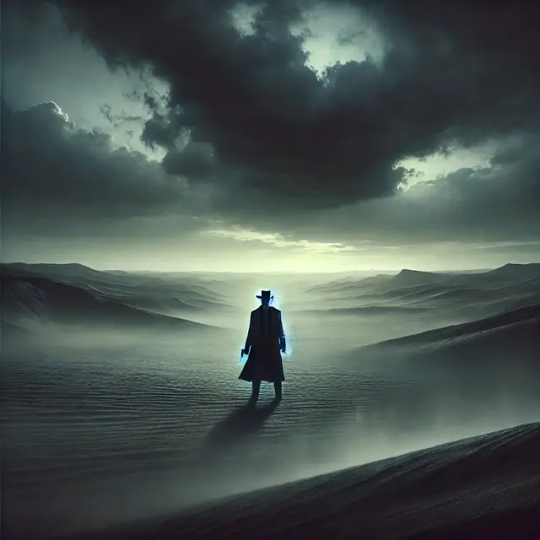
The quest for the Dark Tower is inherently existential, mirroring themes of a seemingly meaningless journey in a decaying world. The adaptation can emphasize the haunting emptiness of Roland’s relentless pursuit and the cyclical nature of his journey, evoking questions of purpose, futility, and despair. Gothic aesthetics—dilapidated landscapes, ominous skies, and echoing corridors within the Tower—can visually reinforce this existential dread.
Example Scene: A recurring nightmare sequence where Roland confronts versions of himself at different points in the cycle. A shifting, spectral Tower looms, reflecting the despair of endless repetition.
Macabre Beauty: The Allure of Decay
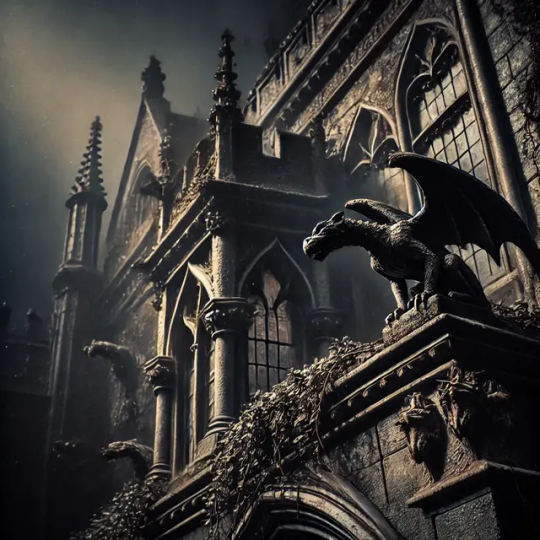
King’s world is a tapestry of decayed glory, perfectly suited for gothic visuals. Flanagan could emphasize contrasts: the grotesque beauty of crumbling castles, decaying forests shrouded in mist, and eerie remnants of Mid-World’s once-vibrant technology. Music, too, can play a role, drawing from ethereal wave and dark ambient soundscapes to underscore hauntingly beautiful moments.
Design Inspirations:
Castle Discordia: Render it as a decayed Baroque masterpiece, filled with grotesque statues and haunting murals.
The Speaking Ring: Surrounded by gnarled, claw-like trees, it glows with a ghostly luminescence, embodying beauty and dread.
Spiritual Isolation: Roland’s Lonely Journey

The alienation Roland feels resonates deeply with gothic themes of spiritual longing and disconnection. His interactions with the ka-tet can be framed as brief glimpses of warmth amidst overwhelming solitude. Flanagan might explore the fragility of these bonds, showcasing Roland’s internal struggle with opening himself to his companions versus his overarching obsession with the Tower.
Key Moments:
A tender but tension-filled fireside scene where Roland shares a fragment of his past with Susannah, only for his stoic mask to slip momentarily before he withdraws again.
Jake's death (or resurrection) steeped in gothic tragedy, with spectral whispers echoing Roland's anguish.
Time and Decay: Mid-World as a Gothic Wasteland
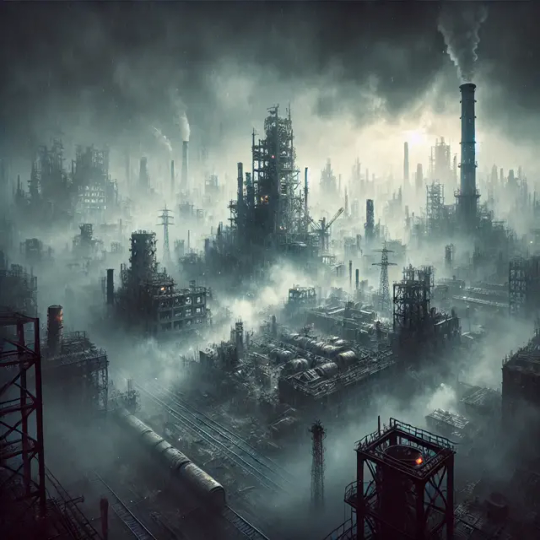
Mid-World’s deterioration is central to its gothic atmosphere. Flanagan could draw parallels to post-apocalyptic ruins, echoing Romanticism’s fascination with the passage of time and the decay of great civilizations. Elements of Shadowhymns’ auditory landscape—droning strings, melancholic whispers—could underscore scenes of Roland traversing empty towns and wastelands.
Worldbuilding Highlights:
Lud: An industrial gothic wasteland, where the clash of ancient technology and primal survival creates an oppressive atmosphere.
The Wastelands: A surreal, almost dreamlike expanse where time seems suspended, populated by haunting echoes of Mid-World’s fallen glory.
Love and Loss: Anchoring Roland’s Humanity
The gothic tradition often intertwines love and loss, making it a poignant focus for Roland’s character. Flanagan might emphasize his fraught relationships, especially with Susan Delgado and Jake, as tragic anchors to Roland’s otherwise implacable demeanor. These moments can be scored with symphonic elements, echoing Lenore's emotive depth.
Example Sequence: A dreamlike montage of Roland dancing with Susan in Mejis, intercut with her fiery demise, blending tenderness with unbearable grief.
Gothic Villains: Monstrous Yet Tragic Figures
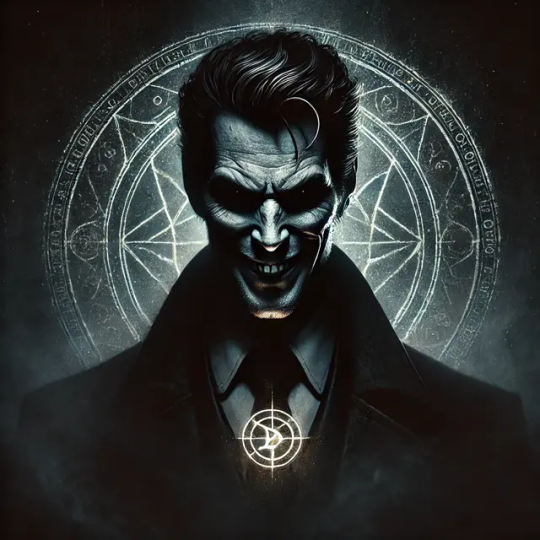
From the Man in Black to Mordred, King’s antagonists embody gothic archetypes of corrupted power and tragic monstrosity. Flanagan could humanize these figures while emphasizing their grotesque allure:
Randall Flagg: Portrayed as a Faustian wanderer, his charm veiling an ancient, malevolent decay.
Mordred: A tragic abomination, his gothic design underscoring the horrors of his creation and eventual fall.
Soundscapes and Atmosphere
To evoke a truly immersive gothic experience, the series could employ a haunting score blending darkwave, ambient, and symphonic elements. Drawing inspiration from Shadowhymns’ melancholic layers and reverberating whispers, the sound design should be as atmospheric as the visuals.
Suggested Approach:
Subtle industrial noises for Lud, inspired by Nine Inch Nails’ dissonant textures.
Ethereal choral arrangements in scenes set within the Dark Tower.
Visual Language: Lighting and Symbolism
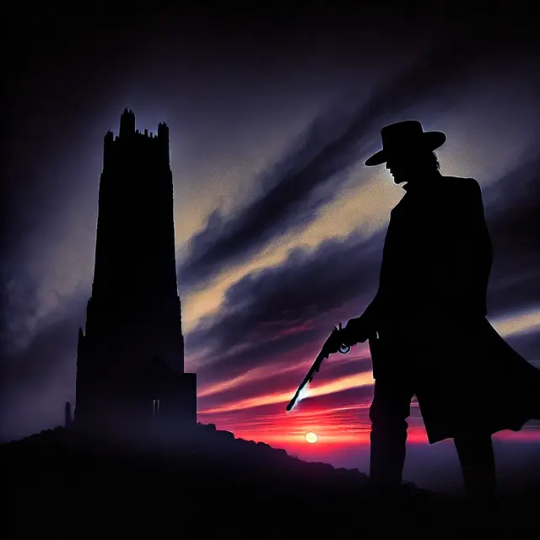
Flanagan’s mastery of lighting and symbolism can amplify the series’ gothic elements. The Tower itself should be a recurring visual motif, appearing in fragmented reflections, silhouettes, and dreams, symbolizing Roland’s obsession. Gothic chiaroscuro lighting—contrasting deep shadows with piercing light—can frame critical moments, creating an eerie, otherworldly tone.
Cinematic Techniques:
Roland silhouetted against the Tower during sunset, the blood-red sky blending with his solitary figure.
The ka-tet framed by flickering torchlight in the bleakness of the Calla, evoking a sense of fragile unity amidst chaos.
Conclusion
Mike Flanagan’s adaptation of The Dark Tower has the potential to be a masterclass in gothic storytelling, weaving existential dread, spiritual isolation, and macabre beauty into a haunting narrative tapestry. By embracing these themes and infusing them with gothic rock’s atmospheric intensity, Flanagan can transform Stephen King’s magnum opus into a visually and emotionally immersive masterpiece.
#TheDarkTower#StephenKing#MikeFlanagan#GothicArt#GothicAesthetic#GothicLiterature#FantasySeries#DarkFantasy#RolandDeschain#KaTet#DarkTowerAdaptation#EtherealImagery#PostApocalypticArt#HauntingBeauty#MacabreArt#AtmosphericVibes#GothicInspiration#FantasyArt#Chiaroscuro#EtherealVibes#DarkAesthetic#DreamlikeVisuals#ExistentialDread#CinematicGothic#SpectralBeauty#FantasyWorldbuilding#LudWasteland#CrimsonRoseSymbolism#RandallFlagg#DarkTowerSeries
0 notes
Text
What Scene From a Movie Traumatised You When You Were Younger?
youtube
For me, it was this. Nosferatu’s elongated shadow creeping up the staircase in Nosferatu: A Symphony of Horror. The way it seemed alive, more terrifying than the figure casting it, haunted me for weeks. I couldn’t walk past a staircase without feeling those spectral fingers reaching for me.
Movies have a way of lodging fear in the corners of your mind, don’t they?
#SpectraNoir#MacabreBeauty#Nosferatu#GothicCinema#SilentHorror#MovieTrauma#EtherealDread#CreepingShadows#ExistentialHorror#HauntingVisuals#DarkAesthetic#SpectralSymphony#TimelessTerror#VintageHorror#CinematicDread#ShadowsAndLight#FearInFilm#IconicHorror#PhantomOfTheScreen#Youtube
1 note
·
View note
Text
"Is Margot Robbie a 10 for You?"

Beauty is a strange and haunting thing. It can captivate, inspire, or alienate—it is subjective as the "eye of the beholder," shaped by a society where we are marks, targeted by marketing firms that brand and rebrand our ideals. When I think of Margot Robbie, I don't see her as a mere number on some arbitrary scale. She is an embodiment of grace, talent, and charisma—a living reflection of what captivates the human spirit.
Margot's beauty transcends the physical. Yes, she has the symmetry and elegance that align with conventional standards—her upturned eyes and radiant smile, her grace both on and off the screen. But what draws me most is her ability to transform. Whether she’s Harley Quinn’s chaotic brilliance or Barbie’s poignant existentialism, her beauty lies in her ability to embody multitudes.

It’s not just skin-deep; it’s soul-deep.
And yet, the question remains—"Is she a 10?" What does that even mean? Reducing someone like Margot Robbie to a number feels shallow, a disservice to what she represents. To me, her beauty isn’t something that can be calculated by the golden ratio or framed by societal ideals. Her allure is an alchemy of talent, depth, and the ineffable quality of presence.
But there’s something else, something darker about this question. It says more about us than it does about her. Why do we feel compelled to quantify beauty? To rank, to dissect, to judge? The very act of assigning a number to someone’s appearance feels sterile, mechanical, and cold. As if beauty is a currency to be valued and exchanged.
Margot Robbie’s appeal isn’t just her face or her form—it’s her humanity, her artistry, and the way she commands a room without uttering a word. For me, that is far more interesting than any superficial assessment.
So, is she a "10"? She’s an infinity—a constellation of qualities that can’t be contained by numbers or words. Beauty isn’t about perfection. It’s about presence, essence, and the way someone makes the world feel a little more alive.
That, to me, is more powerful than any scale could ever convey.
#SpectraNoir#MargotRobbie#BeautyStandards#GothicPerspective#SubjectiveBeauty#ArtisticExpression#CelebrityCulture#HauntingThoughts#DeepReflections#BarbieMovie#HarleyQuinn#GoldenRatio#TumblrAesthetic#Existentialism#PopCultureAnalysis#ModernBeauty#GothicMusings
1 note
·
View note
Text
The Saddest Film Endings
1. The Green Mile (1999)

Directed by Frank Darabont, The Green Mile tells the story of Paul Edgecomb, a death row prison guard, and John Coffey, an innocent man with miraculous healing powers. The film's devastating ending sees Coffey executed despite his innocence, leaving Paul and viewers grappling with the cruelty of humanity.
Why It’s Heartbreaking: Coffey’s death underscores themes of injustice and the fragility of goodness in a flawed world. The emotional weight comes from the bond formed between Coffey and Paul, making his loss feel deeply personal.
2. Grave of the Fireflies (1988)

This animated Japanese film by Isao Takahata depicts the harrowing lives of two siblings struggling to survive during World War II. The ending reveals their ultimate fate in a stark, unflinching portrayal of loss.
Why It’s Heartbreaking: The film’s intimate focus on Seita and Setsuko’s bond makes their tragic deaths feel unavoidable yet profoundly unfair. It’s a sobering reminder of war’s devastating impact on the innocent.
3. Requiem for a Dream (2000)
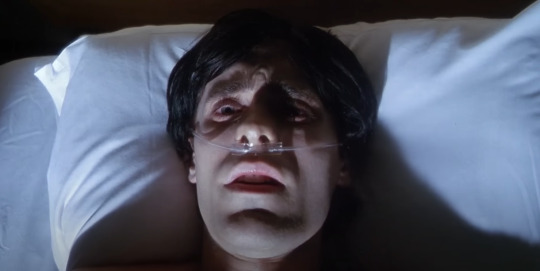
Darren Aronofsky’s grim tale of addiction spiraling out of control leaves every character in a state of utter despair. The final montage shows them broken physically, emotionally, and spiritually, with no hope for redemption.
Why It’s Heartbreaking: The ending offers no catharsis, only a raw portrayal of human suffering. The characters’ descent into their own personal hells leaves a lingering sense of emptiness.
4. Titanic (1997)
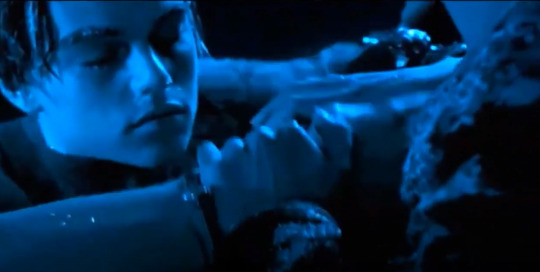
James Cameron’s epic love story culminates in the heartbreaking death of Jack Dawson, who sacrifices himself so Rose can survive. The film’s final moments, showing an elderly Rose reuniting with Jack in the afterlife, cement its emotional impact.
Why It’s Heartbreaking: The loss of young love combined with the massive human tragedy of the Titanic’s sinking creates a dual layer of sorrow that resonates universally.
5. Schindler’s List (1993)

Steven Spielberg’s historical drama ends with Oskar Schindler breaking down as he realizes he could have saved more lives during the Holocaust. The film closes with a powerful scene of Holocaust survivors honoring Schindler’s memory.
Why It’s Heartbreaking: Schindler’s grief and the sheer magnitude of the Holocaust’s horrors leave viewers overwhelmed by the weight of both individual and collective loss.
6. The Boy in the Striped Pajamas (2008)

This World War II drama follows the friendship between a young German boy and a Jewish boy in a concentration camp. The devastating climax sees them both killed in a gas chamber.
Why It’s Heartbreaking: The innocence of the children and the senselessness of their deaths amplify the tragedy of the Holocaust, leaving viewers haunted by its cruelty.
What Makes a Film Ending the Saddest?
A truly heartbreaking ending often includes:
Emotional Investment: Deeply developed characters and relationships make their losses feel personal.
Themes of Injustice or Sacrifice: Unfair outcomes or selfless acts amplify the sorrow.
Lack of Resolution: Films that leave characters or situations unresolved can intensify feelings of grief.
Universal Resonance: Stories that reflect shared human experiences—love, loss, and mortality—leave a lasting impact.
Conclusion
Films like The Green Mile, Grave of the Fireflies, and Schindler’s List consistently stand out for their ability to evoke deep, universal sorrow. Each ending leaves audiences not only mourning the characters but also reflecting on larger themes of humanity, loss, and the fragility of life. The power of these stories lies in their capacity to turn sorrow into a profound, unforgettable experience.
#Saddest Movie Endings#Emotional Movies#Heartbreaking Films#The Green Mile#Grave of the Fireflies#Titanic#Requiem for a Dream#Schindler’s List#The Boy in the Striped Pajamas#Film Analysis#Movie Moments#Movie Lovers#Film Buff#Cinematic Masterpieces#Movie Critique#Heartbreaking Endings#Emotional Cinema#Sad Film Moments#Classic Movies#Movie Recommendations#Iconic Films#Cinephile Community#Film Discussion#Tumblr Movies#Cinematic Feels#Tragic Movie Endings#Oscar-Worthy Films
12 notes
·
View notes
Text
Exploring Jonathan Shaw’s Potential Future in the Terrifier Series

In the Terrifier series, Jonathan Shaw, the younger brother of protagonist Sienna Shaw, plays a pivotal role, especially in Terrifier 2 and Terrifier 3. His character arc intertwines deeply with the narrative's exploration of trauma, resilience, and the supernatural.
Jonathan's Fate in Terrifier 3
In Terrifier 3, Jonathan's fate is shrouded in ambiguity. He is last seen in his dorm room, and subsequent events suggest he may have fallen victim to Art the Clown and Victoria Heyes. Sienna is presented with a disfigured head, purported to be Jonathan's, but the evidence is inconclusive. The head's flesh is peeled off, making identification difficult, and the only link to Jonathan is a pair of glasses placed on it by Victoria, who has previously lied about the head's identity. This leaves room for doubt about Jonathan's actual fate.
Screen Rant
Director's Insights
Director Damien Leone has addressed the off-screen nature of Jonathan's presumed death, acknowledging fan reactions and suggesting that the character's fate is intentionally left uncertain. Leone emphasizes that his characters are unpredictable and not to be trusted, hinting that Jonathan's story may not be concluded.
Entertainment Weekly
Potential for Redemption or Resurrection
The Terrifier series delves into supernatural elements, particularly with Art the Clown's enigmatic nature and apparent immortality. Jonathan's deep connection to the lore, especially his understanding of Art's demonic essence and the significance of the pale girl as a vessel, positions him as a character with potential for further development. Given the series' thematic focus on resurrection and the battle between good and evil, it's plausible that Jonathan could return in future installments, possibly undergoing a redemption arc or playing a crucial role in confronting the malevolent forces.
Conclusion
While Terrifier 3 leaves Jonathan Shaw's fate ambiguous, narrative clues and directorial comments suggest that his story may not be over. The series' exploration of supernatural themes and the character's integral role in the overarching narrative provide fertile ground for a potential redemption or resurrection arc in future films. Fans will need to await further installments to see how Jonathan's journey unfolds.
#Terrifier#Terrifier Movie#Terrifier 2#Terrifier 3#Jonathan Shaw#Sienna Shaw#Art the Clown#Horror Movies#Horror Analysis#Supernatural Horror#Horror Character Arc#Redemption Arc#Resurrection Themes#Horror Lore#Terrifier Theories#Damien Leone#Pale Girl#Horror Fans#Horror Community#Slasher Films#Horror Protagonists#Horror Antagonists#Psychological Horror#Supernatural Themes#Horror Essays#Horror Symbolism#Movie Analysis
28 notes
·
View notes
Text
Exploring the Symbolic and Psychological Duality in the Terrifier Series

The Terrifier film series, directed by Damien Leone, is a chilling foray into the macabre, centering on the enigmatic and brutal antagonist Art the Clown. Set against desolate urban backdrops and imbued with a nihilistic tone, the films explore the relentless violence and psychological torment Art inflicts on his victims. Unlike traditional horror villains, Art is a mute, grotesque figure whose exaggerated expressions and theatricality unsettle as much as his savagery. His lack of clear motive or humanity makes him a unique and deeply unnerving presence in modern horror.
At the heart of Terrifier lies a profound dynamic between Art and his victims, particularly the protagonists who emerge as central figures in each installment. Art serves as more than a physical threat; he embodies the protagonists’ deepest fears and suppressed emotions, functioning as a dark passenger that reflects and magnifies their inner struggles. This paper explores how Art the Clown operates as a symbolic and psychological mirror, forcing the protagonists to confront the duality of their humanity—order and chaos, light and darkness—in a battle for survival and self-realization.
Art the Clown's Role: The Emotional and Existential Specter
Art the Clown is not merely a slasher villain; he is a harbinger of chaos and despair, transcending the role of a physical antagonist to become an emotional and existential specter in the lives of his victims. His actions—often grotesque and theatrically sadistic—are not random; they are deeply symbolic, creating a psychological battlefield where the characters' fears and vulnerabilities are exposed.
A Manifestation of Chaos

Art’s mute, mime-like demeanor contrasts with his flamboyant, grisly acts of violence, making him a walking contradiction—a living embodiment of chaos. His silence is deafening, forcing both characters and audiences to grapple with his incomprehensibility. By refusing to explain his motives, Art transcends the typical horror archetype, becoming an existential specter of the absurd. His presence challenges the natural order, reducing the characters’ world to a surreal nightmare where rules, morality, and logic no longer apply.
The Theater of Fear
Art’s actions often mimic a grotesque performance, turning his killings into macabre spectacles. This theatricality suggests that Art’s violence is not just about physical destruction but about psychological domination. For instance, his mocking expressions, exaggerated movements, and deliberate cruelty seem designed to erode his victims’ sense of self. He turns their suffering into a perverse art form, forcing them to confront their powerlessness.
Catalyst for Confronting Inner Demons

Art’s role extends beyond being an external threat; he operates as a catalyst for his victims to face their own inner demons. In Terrifier 1, Tara Heyes struggles with her vulnerability and the randomness of violence. Art’s relentless pursuit exposes her lack of control, mirroring the existential dread of living in a chaotic, indifferent universe. In Terrifier 2, Sienna Shaw's journey as a reluctant hero is intertwined with Art’s presence. As she dons her symbolic armor to face him, their clash becomes a battle of dualities: her burgeoning strength and hope against his nihilistic destruction. Art’s ability to survive fatal injuries and his supernatural undertones emphasize his role as more than a man—he is the darkness that cannot be easily vanquished.
A Mirror to Humanity’s Shadow
Art operates as a reflection of the shadow self, the darker, primal aspects of human nature that individuals often suppress. He embodies the impulses society fears—violence, chaos, and amorality—and forces his victims to confront these elements within themselves. The protagonists are not only fighting Art; they are fighting the despair, rage, and fear he brings to the surface. His presence compels them to wrestle with their capacity for survival, morality, and resilience.
An Existential Specter
By stripping away the safety of logic and reason, Art transforms into a figure of existential horror. His interactions with the protagonists do not offer catharsis or closure but leave them (and viewers) grappling with unanswerable questions. What does it mean to face an enemy that embodies pure meaninglessness? What happens when the order of life is disrupted by a force that is both incomprehensible and unstoppable? These are the questions Art forces his victims—and by extension, the audience—to confront.
Art the Clown’s role as an emotional and existential specter elevates Terrifier from conventional gore-fest to a meditation on fear, chaos, and the fragility of human existence. Through his grotesque theatrics and haunting presence, he becomes a symbol of the darkness within and the external forces that challenge individuals to find meaning and strength amidst the void.
Analysis of Protagonist and Antagonist Dynamics in Terrifier 1, 2, and 3
The Terrifier series showcases a profound evolution in the dynamic between Art the Clown and the protagonists, shifting from a narrative of helpless victimization in the first installment to one of resilience and empowerment in the sequels. This progression culminates in Terrifier 3, where the interplay between Art and Sienna Shaw transcends the physical conflict, delving into deeper symbolic and psychological realms.
Terrifier 1: Chaos vs. Vulnerability
The relationship between Art and Tara Heyes in the first film serves as an exploration of chaos overwhelming humanity. Tara’s arc is marked by her vulnerability and desperate attempts to impose meaning and control in a nightmarish situation. Art, on the other hand, is an unrelenting force of absurdity and destruction.
Symbolic Duality:
Tara seeks survival and coherence, while Art thrives in disarray. Their shared setting—a decrepit building—becomes a stage for Art’s chaos and Tara’s unraveling.
Tara’s humanity and emotional depth contrast sharply with Art’s inhuman detachment, making her demise a poignant statement on the fragility of human order when confronted by pure nihilism.
Terrifier 2: Hope vs. Despair

In Terrifier 2, the dynamic shifts to a battle of mythic proportions, as Sienna Shaw embodies a heroic archetype in direct opposition to Art’s malevolence. Sienna’s arc centers on her transformation from a grieving and uncertain figure to a warrior capable of confronting darkness head-on.
Parallels and Contrasts:
Both Sienna and Art possess theatrical qualities, with her Valkyrie-inspired armor symbolizing hope and renewal, while Art’s grotesque costume embodies corruption and despair.
Sienna’s struggle to process trauma and her eventual empowerment mirror Art’s role as a catalyst for chaos and destruction. The supernatural elements surrounding both characters emphasize their symbolic duality as light and dark forces.
Narrative Evolution:
Unlike Tara, Sienna takes an active role in her fight against Art, suggesting a thematic shift from helplessness to the possibility of overcoming inner and outer demons.
Terrifier 3: Transformation and Confrontation
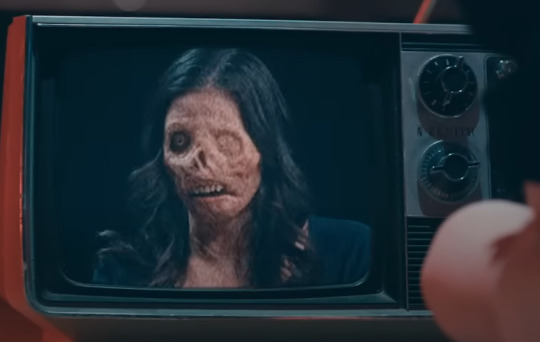
In Terrifier 3, the interplay between Art and Sienna deepens, with heightened stakes and symbolic resonance. Art’s return is marked by a growing supernatural presence and a partnership with Victoria Heyes, who has been corrupted into a vessel of evil. This alliance expands Art’s role as a harbinger of dread, introducing an existential layer to his menace.
Sienna’s Heroic Arc:
Following the events of Terrifier 2, Sienna grapples with lingering trauma while striving to rebuild her life. Her transformation continues as she confronts her deepest fears, becoming a proactive force against Art’s chaos.
Her symbolic growth is highlighted by the Christmas season, a time traditionally associated with hope and renewal, contrasting Art’s perverse embodiment of corruption as a twisted Santa Claus figure.
Symbolic and Psychological Themes:
Art continues to act as a mirror to Sienna, magnifying her internal struggles and challenging her resilience. His theatrical brutality and supernatural resilience force Sienna to embrace her heroic identity fully, turning their clash into a cosmic battle of despair versus hope.
The introduction of Victoria Heyes as Art’s partner underscores the broader implications of Art’s menace, suggesting his influence extends beyond personal conflict to systemic and existential levels.
Overarching Themes and Symbolism
Across the trilogy, the dynamic between Art and the protagonists evolves from physical terror to a symbolic confrontation of existential themes. Art serves as a manifestation of chaos and despair, compelling his victims to confront their vulnerabilities, while the protagonists’ arcs reflect humanity’s potential for resilience and transformation.
Progression of Light vs. Dark:
In Terrifier 1, chaos triumphs over order, leaving a sense of helplessness.
In Terrifier 2, hope emerges as a counterforce, embodied by Sienna’s rise as a warrior.
In Terrifier 3, the conflict reaches its zenith, presenting Art and Sienna as mythic figures in an eternal battle of light against darkness.
Through these dynamics, Terrifier transcends the boundaries of traditional slasher films, using its protagonist-antagonist relationships to explore deeper psychological, symbolic, and existential themes. This progression not only enriches the narrative but also redefines what the genre can achieve.
Symbolic and Psychological Themes in the Terrifier Series

Art the Clown's character in the Terrifier series functions as more than a sadistic killer; he is an externalized manifestation of internal conflict and repressed fears. Through the lens of Jungian psychology and other psychological theories, Art’s role can be understood as a symbolic shadow figure, a representation of humanity’s suppressed darkness and existential anxieties.
The Jungian Shadow
Carl Jung’s concept of the shadow refers to the hidden, unconscious aspects of the psyche—those traits and instincts that individuals deny or suppress because they conflict with societal norms or personal ideals. The shadow often includes primal urges, unprocessed trauma, and latent fears. Art the Clown embodies this shadow in grotesque and exaggerated ways, forcing his victims to confront these disowned parts of themselves.
Art as the Shadow of Chaos:
Art’s irrational, anarchic behavior mirrors the chaos that lurks beneath the surface of the protagonists’ orderly lives. For Tara Heyes (Terrifier 1), his relentless pursuit reflects her fear of vulnerability and the fragility of human control. For Sienna Shaw (Terrifier 2), Art manifests as an obstacle to her healing and empowerment, symbolizing the internal battles she must overcome to embrace her identity as a hero.
Projection and Confrontation:
Jungian theory suggests that encountering the shadow is a necessary step for personal growth. The protagonists’ battles with Art force them to confront their fears, vulnerabilities, and suppressed desires. For Sienna, Art’s chaos and violence contrast with her struggle for meaning and purpose, highlighting the need to integrate her shadow—acknowledging her fears without being consumed by them.
Existential Dread and the Absurd
Art’s character also embodies themes of existential dread and the absurd, resonating with the works of existentialist thinkers like Søren Kierkegaard, Jean-Paul Sartre, and Albert Camus.
The Absurdity of Art’s Violence:
Art’s seemingly motiveless brutality underscores the absurdity of existence, a universe indifferent to human suffering or order. His actions defy logic, stripping away the protagonists’ ability to rationalize or understand their plight, much like existentialists describe the human condition as inherently without meaning.
Existence vs. Nihilism:
For the protagonists, Art’s chaos represents the void of nihilism, where life lacks purpose or coherence. Their resistance to him, particularly Sienna’s transformation in Terrifier 2 and 3, mirrors the existentialist idea of creating meaning through action and defiance in the face of absurdity.
Freudian Drives and the Id
Freud’s psychoanalytic theory divides the psyche into the id, ego, and superego. Art can be seen as a personification of the id—unchecked, primal instincts that operate without regard for morality or consequence.
Art as the Primal Id:
Art’s behaviors are driven by a base, sadistic pleasure in destruction and domination, devoid of rational thought or higher purpose. He is pure impulse, embodying Freud’s concept of the death drive (thanatos), the instinct toward aggression and entropy.
Confronting the Repressed:
The protagonists, in contrast, represent the ego’s struggle to mediate between the id’s chaotic impulses and the superego’s moral codes. Art’s intrusion into their lives forces them to confront these primal drives within themselves, particularly their own capacity for violence, fear, and survival instincts.
Symbolic Mirroring
Art’s theatrical, exaggerated behavior acts as a distorted mirror to the protagonists, reflecting the parts of themselves they wish to deny.
Sienna Shaw’s Reflection:
In Terrifier 2, Sienna’s heroic arc and Art’s malevolence mirror each other in their theatricality and symbolic roles. While Art wields his clown persona to mock and destroy, Sienna’s Valkyrie-like costume becomes a symbol of her empowerment and resilience. This duality represents the Jungian process of individuation, where confronting and integrating the shadow leads to a unified and empowered self.
Victoria Heyes as the Corrupted Mirror:
In Terrifier 3, Victoria Heyes’ transformation into Art’s ally suggests the consequences of failing to confront and integrate the shadow. Her descent mirrors Art’s role as a figure of chaos, highlighting the danger of being consumed by repressed fears and impulses.
The Collective Shadow
Art’s impact extends beyond individual psyches to encompass societal and collective fears. As a supernatural figure, he channels cultural anxieties about randomness, violence, and the breakdown of social order.
Art as a Cultural Mirror:
His unrelenting violence and lack of motive reflect modern fears of senseless aggression and the fragility of societal structures. Art forces not only the protagonists but also the audience to confront the uncomfortable reality of humanity’s darker impulses.
Conclusion

The Terrifier series, through its haunting interplay between Art the Clown and the protagonists, transcends the conventions of the slasher genre to deliver a profound exploration of psychological and existential themes. Art is not just a killer; he is a manifestation of chaos, nihilism, and the Jungian shadow, forcing characters and audiences alike to confront the darkest parts of the human psyche. Each protagonist, from Tara Heyes to Sienna Shaw, undergoes a transformative journey, with their struggles against Art reflecting humanity’s broader battle with fear, trauma, and the search for meaning.
In Terrifier 1, Art’s triumph over Tara illustrates the fragility of human order when faced with unrelenting chaos. In Terrifier 2, Sienna’s emergence as a symbol of hope elevates the narrative to a mythic battle between light and dark, chaos and resilience. Finally, Terrifier 3 deepens these themes, positioning Art as a cosmic force of destruction and Sienna as a beacon of defiance, showcasing the psychological and symbolic dualities that drive the series.
The broader implications for horror storytelling are significant. The Terrifier films demonstrate how the relationship between protagonist and antagonist can serve as a mirror for internal conflicts, adding psychological depth to the genre. By portraying Art as an externalized shadow and an agent of existential dread, the series challenges audiences to grapple with universal fears and uncertainties. In doing so, Terrifier not only delivers visceral horror but also elevates the genre, turning its blood-soaked narrative into a meditation on the human condition. This fusion of terror and introspection cements Terrifier as a standout work, pushing the boundaries of what horror can achieve.

#Terrifier#Terrifier Movie#Terrifier Analysis#Art the Clown#Sienna Shaw#Horror Movies#Psychological Horror#Horror Analysis#Jungian Psychology#Shadow Archetype#Horror Protagonists#Horror Antagonists#Slasher Films#Existential Horror#Chaos vs Order#Movie Analysis#Horror Fans#Horror Community#Symbolism in Horror#Terrifier 2#Terrifier 3#Dark Passenger#Horror Storytelling#Film Analysis#Horror Genre#Horror Symbolism#Horror Theory#Modern Horror#Gothic Horror#Existential Dread
0 notes
Text
The Gothic Heart of "Prison Break"
In the winding corridors of Fox River Penitentiary, "Prison Break" spins a tale far deeper than just a prison escape. It's a narrative that taps into some of the most haunting elements of gothic storytelling. While the show is primarily a thriller-drama, its themes and settings resonate deeply with the gothic tradition, where darkness, despair, and the struggle against unseen forces play central roles.
1. Confinement and Entrapment
Gothic literature thrives on settings that are dark, oppressive, and confining. Think of the crumbling castles, eerie mansions, or even the treacherous landscapes that seem to close in around the characters. "Prison Break," set in the foreboding walls of a maximum-security prison, channels this energy of confinement. The prison becomes a modern gothic fortress, a place where every turn is a dead end and every corridor echoes with the footsteps of despair.
2. Struggle Against Oppression
A core element of gothic tales is the battle against overpowering forces—whether they be supernatural, psychological, or societal. "Prison Break" is a modern epic of rebellion against such forces. The characters are not just escaping a physical prison; they are fighting a corrupt system, a faceless bureaucracy that traps them in a cycle of fear and control. This echoes the gothic theme of individuals fighting against a greater, often malevolent power, creating an atmosphere of existential dread and helplessness.
3. Psychological Complexity and Madness
One of the most captivating aspects of "Prison Break" is its deep dive into the psychological turmoil of its characters. Michael Scofield’s descent into obsession, his meticulous plans, and his grappling with his own sanity mirror the gothic fascination with madness. The show explores that fine line between brilliance and insanity, a theme that permeates many gothic narratives where characters are haunted by their inner demons as much as by their external enemies.
4. Dark Secrets and Revelations
Gothic stories are filled with dark secrets, hidden passages, and unexpected revelations. "Prison Break" is no different. It thrives on the unknown—hidden agendas, secret alliances, and buried pasts. Each episode unravels a new layer of deception or unveils a hidden truth, much like a gothic novel where each turn of the page draws you deeper into a mystery shrouded in darkness.
5. The Haunted Past
The characters in "Prison Break" are haunted, not by ghosts in the traditional sense, but by their pasts. Michael’s guilt, Lincoln’s wrongful conviction, and the myriad sins of the other inmates create a haunting that is deeply personal and psychological. This aligns perfectly with gothic themes, where characters are often pursued by the specters of their own actions and choices.
6. Atmospheric and Visual Elements
While "Prison Break" may not drape itself in the classic visual trappings of gothic literature, it captures the essence through its setting and mood. The prison’s shadowed halls, its towering walls, and the pervasive sense of decay all contribute to an atmosphere that is unmistakably gothic. The stark, imposing architecture of Fox River becomes a character in itself—a cold, unforgiving beast that looms over every scene.
7. The Antihero and Moral Ambiguity
The gothic genre loves its antiheroes—those morally ambiguous figures who walk the line between good and evil. Michael Scofield embodies this perfectly. He is both a savior and a criminal mastermind, his actions driven by a desperate love for his brother and a willingness to blur moral lines to achieve his ends. This complexity adds a rich layer to the narrative, similar to the gothic fascination with characters who defy simple categorization.
8. Fatalism and Tragic Romance
"Prison Break" flirts with fatalism and tragic romance. Relationships in the series are often strained, tested, or doomed by the dark circumstances of them. Love stories in "Prison Break" carry the weight of tragedy, much like the gothic tradition, where romance often leads to doom, despair, or death.
By composing these gothic elements into its narrative, "Prison Break" becomes more than just a story about escaping prison. It’s a descent into a modern-day gothic where every character is haunted by their own shadows, every decision carries the weight of fate, and every path is shrouded in darkness. A reminder that even in the most unlikely of places, the gothic tradition thrives, whispering its secrets from behind iron bars.
Share your thoughts on how "Prison Break" resonates with gothic themes!
#PrisonBreak#GothicThemes#DarkStorytelling#PsychologicalThriller#ExistentialDread#ModernGothic#TVAnalysis
2 notes
·
View notes
Text
The Gate II: Embracing the Unseen Journey
In contemplating the essence of the black sheep, one sees it is not merely about being misunderstood or overlooked. It is about discovering beauty in shadows, in moments others dismiss. "The Gate II" embodies this essence—a sequel lingering in the shadow of its predecessor, waiting to be rediscovered.
The journey begins with a familiar sense of dread. Released in 1990, it followed "The Gate," a cornerstone of childhood horror. The first film left a mark with its eerie atmosphere and Steven Dorff's debut, but the sequel ventured into less chartered, more sinister waters.
Directed by Tibor Takács and penned by Michael Nankin, the film revisits a world steeped in the supernatural. This time, it’s not about old haunts but about exploring new depths. With a budget akin to its predecessor, the film continued the visual effects mastery that defined the series.
For me, this journey was not just watching from afar but delving into the heart of the story. Pamela Adlon's portrayal of Liz, a curious beacon in the occult, added intrigue. Alongside Lewis Tripp's return as Terry, grappling with demons amidst chaos, the cast painted a canvas of developing motivations and human vulnerabilities.
"The Gate II" took risks. It ventured into darker territories, exploring themes of loss and the consequences of unchecked desires. As Terry sought to reclaim what was lost, he unleashed forces beyond control. The demons that emerged mirrored our darker desires—twisted, unpredictable, haunting.
The film's R rating puzzled many, expecting overt horror but finding a nuanced exploration of human frailty. It was a reminder that horror isn’t always about gore or jump scares; sometimes, it’s about the horrors we create within.
Among the standout moments were Terry's nightmares, depicting his father's descent into darkness. These sequences resonated, not just for their visual impact, but for the emotional depth they brought to Terry’s journey. They blended horror with poignant storytelling.
As the narrative unfolded, each wish granted by the malevolent forces came at a price. It was a cautionary tale wrapped in a supernatural guise—a reminder that desires fulfilled carry unforeseen consequences. Mo and Jon's transformations into demons were vivid reminders of this truth, their struggles to reveal human nature's complexities.
In its climactic moments, "The Gate II" found redemption in sacrifice. Terry's last battle against the forces he unleashed was not just survival, but a reckoning with his choices. The closing scenes, with their practical effects and old-school charm, left a sense of nostalgia—a nod to an era of hands-on horror crafting.
Looking back, "The Gate II" is a testament to storytelling's enduring power. It reminds us that even in shadows, stories await voices long to be heard. As a fan, it’s not just about defending an underdog; it’s about celebrating narratives that dare to venture into the unknown.
To those who seek hidden treasures in horror, I urge you: embrace "The Gate II." It may not be flawless, but within its depths lie traces of our fears and hopes.
#EmbraceTheUnseen#HorrorGems#RediscoverTheGate#HiddenHorror#BlackSheepCinema#90sHorror#CultClassics#SupernaturalTales#EerieCinema#HorrorNostalgia#UnderratedHorror#HauntingJourneys#DarkNarratives#SpookyStories#HorrorFansUnite#GothicCinema#ExploringTheUnknown#TalesFromTheShadows
0 notes